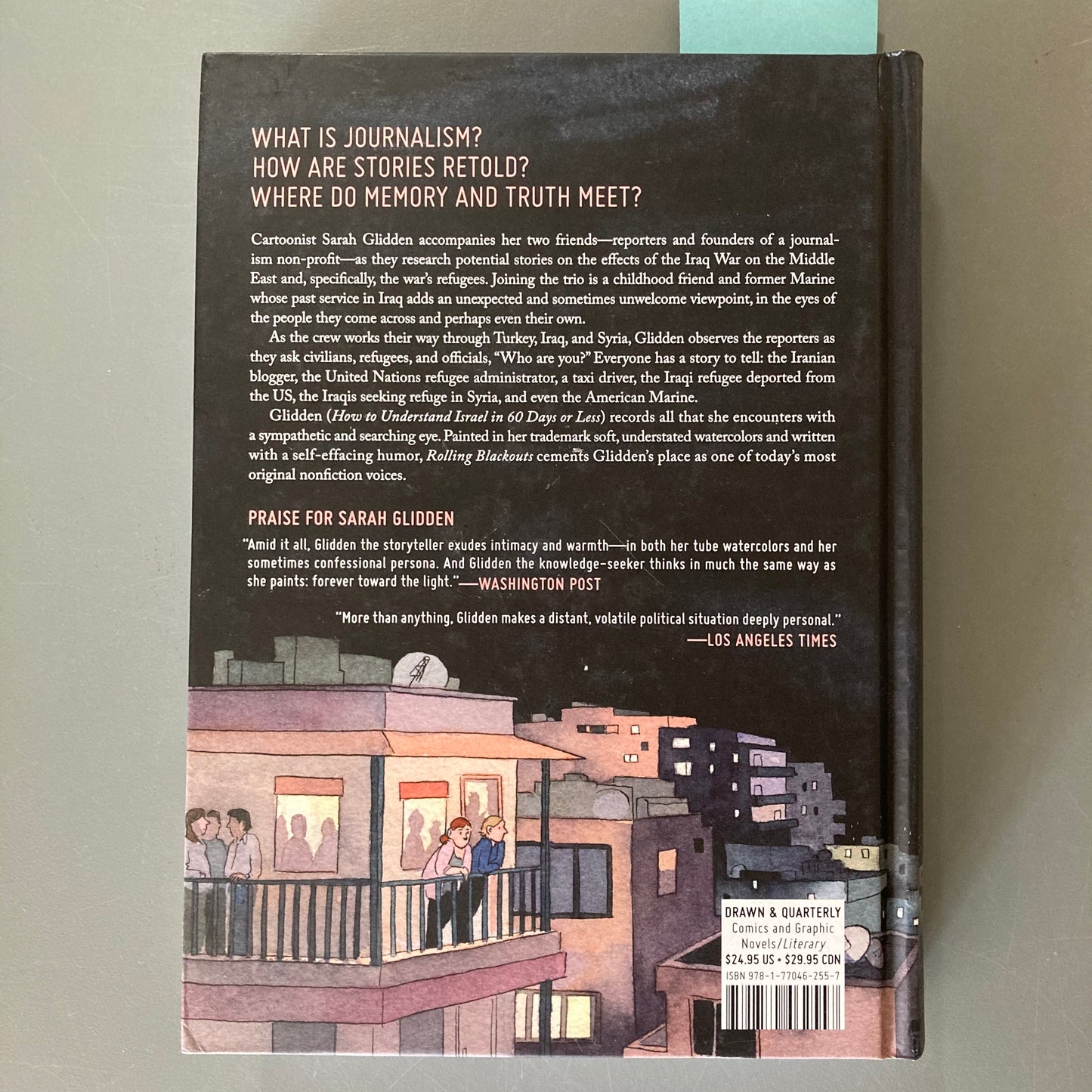Along with telling moving stories, Glidden does an excellent job of drawing our attention to the successes and pitfalls of journalism—in fact, this book—which begins and ends with the question, “What is journalism?”—could function as an innovative journalism textbook.
World Literature Today
Rolling Blackouts
Rolling Blackouts
Couldn't load pickup availability
By Sarah Glidden. Published by Drawn& Quarterly.
Hardcover, 304 pages, Colour, 2016.
A CARTOONIST FOLLOWS REPORTERS ACROSS THE MIDDLE EAST, LEARNING ABOUT JOURNALISM AND HOW STORIES ARE TOLD
Cartoonist Sarah Glidden accompanies her two friends—reporters and founders of a journalism non-profit—as they research potential stories on the effects of the Iraq War on the Middle East and, specifically, the war’s refugees. Joining the trio is a childhood friend and former Marine whose past service in Iraq adds an unexpected and sometimes unwelcome viewpoint, both to the people they come across and perhaps even themselves.
As the crew works their way through Turkey, Iraq, and Syria, Glidden observes the reporters as they ask civilians, refugees, and officials, “Who are you?” Everyone has a story to tell: the Iranian blogger, the United Nations refugee administrator, a taxi driver, the Iraqi refugee deported from the US, the Iraqis seeking refuge in Syria, and even the American Marine.
Glidden (How to Understand Israel in 60 Days or Less) records all that she encounters with a sympathetic and searching eye. Painted in her trademark soft, muted watercolors and written with a self-effacing humor, Rolling Blackouts cements Glidden’s place as one of today’s most original nonfiction voices.
Praise for Rolling Blackouts
Sensitively handled with subtlety and humor (not to mention Glidden’s beautiful watercolor illustrations), the result is something that never stops being curious, kind, and touchingly human...
WIRED
Rolling Blackouts resembles the work of [Glidden's] great hero, Joe Sacco ... at least in the sense that it is about as serious and careful as a comic can possibly be [with] a gentleness that is all its own, perhaps because Glidden works mostly in soft watercolour, a medium that seems somehow to reflect her refusal to deal in certainties.
The Guardian
Sarah Glidden’s remarkable Rolling Blackouts adds a new twist to the [graphic journalism] form. Glidden accompanies a team of journalists through Syria and Iraq and her muted watercolours record not only the lives of people in war zones but the way the media interacts with them. Highly recommended.
The Guardian
Glidden pays careful respect to the unknown: Her lucid watercolours document all she can see of concrete reality, expertly capturing landscape and body language, beneath which reside unfathomable depths.
The Globe and Mail
[Glidden’s] technique, combined with dozens of hand-painted snapshots of each of her subjects, feels more personal than simply text or images alone. By making these experiences feel so personal, Ms Glidden has helped to emphasise the seriousness of their struggle.
The Economist
An ambitious, nuanced and sprawling work of graphic nonfiction.
Anna Fitzpatrick, Rolling Stone
With a journalist’s eye, Glidden paints a powerful portrait of war-torn communities based on her own travels.
Publishers Weekly Fall Preview
Glidden fills an important void by making foreign conflicts accessible to people who might not subscribe to Foreign Affairs or Washington Monthly. There’s a whimsical quality to her watercolor illustrations. Edges are round, and cheeks are rosy. The effect is friendly, welcoming and personal—nothing like the camo-and-sand anonymity in most reporting on the Middle East.
Newsweek
She is at the forefront of a new generation of journalists using comics to tell important stories.
Macleans
Glidden’s clean, spare cartoons take a behind-the-scenes approach.
Harper's Magazine
What is journalism? What role does narrative and story play in reporting the news in conflict zones, and how do media makers choose the stories they tell? These are some of the central questions.
Bookwitty





